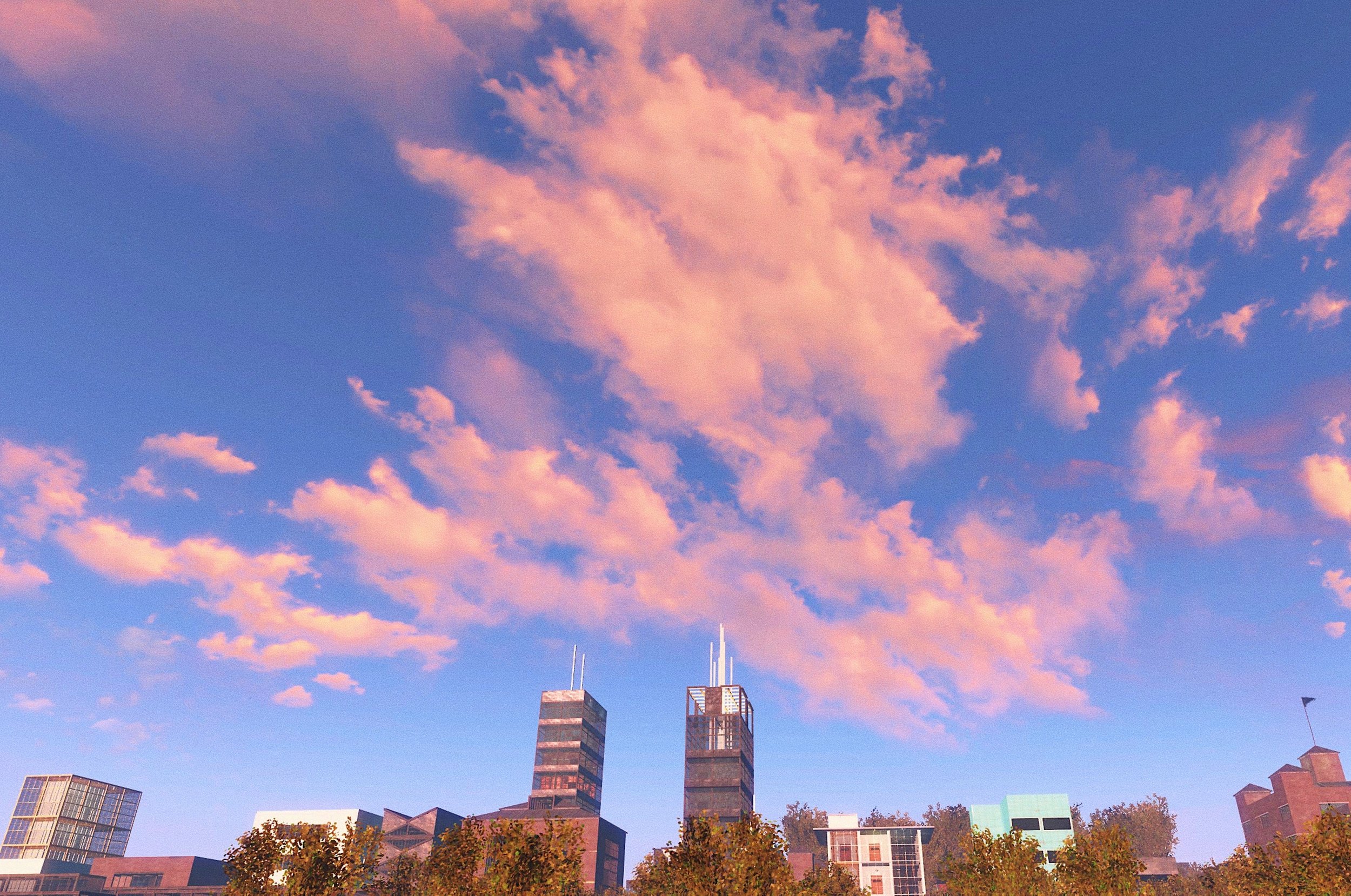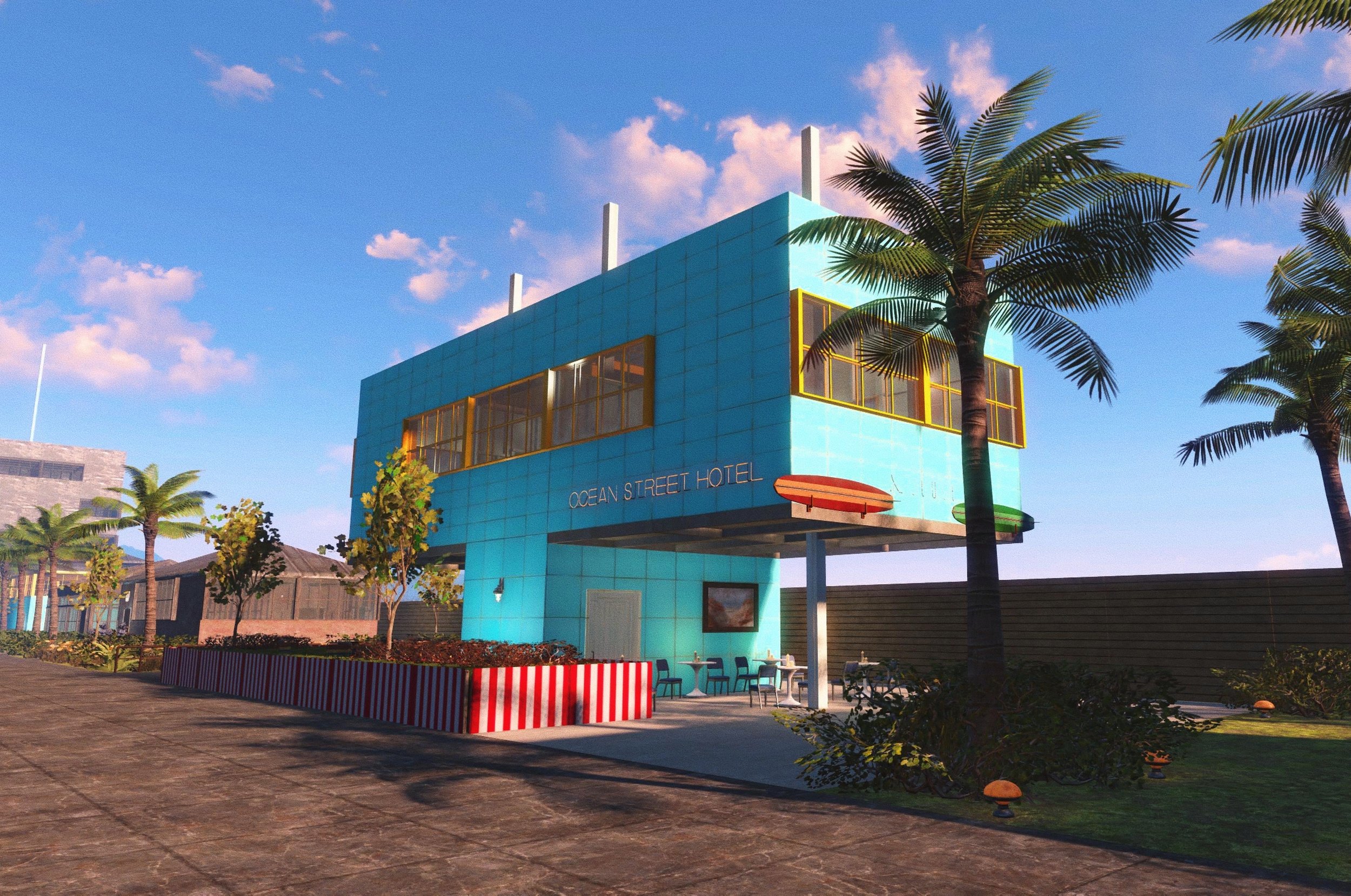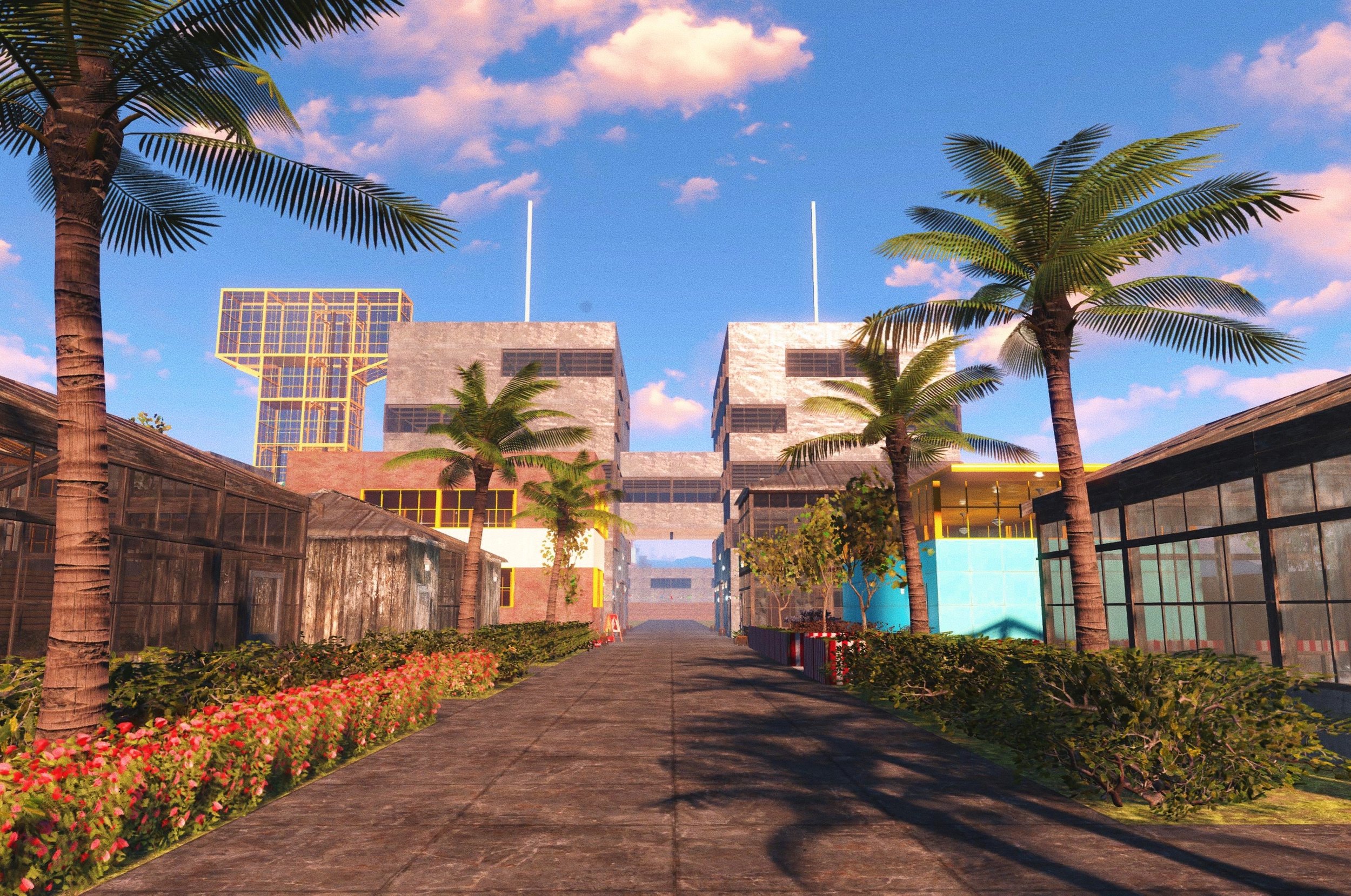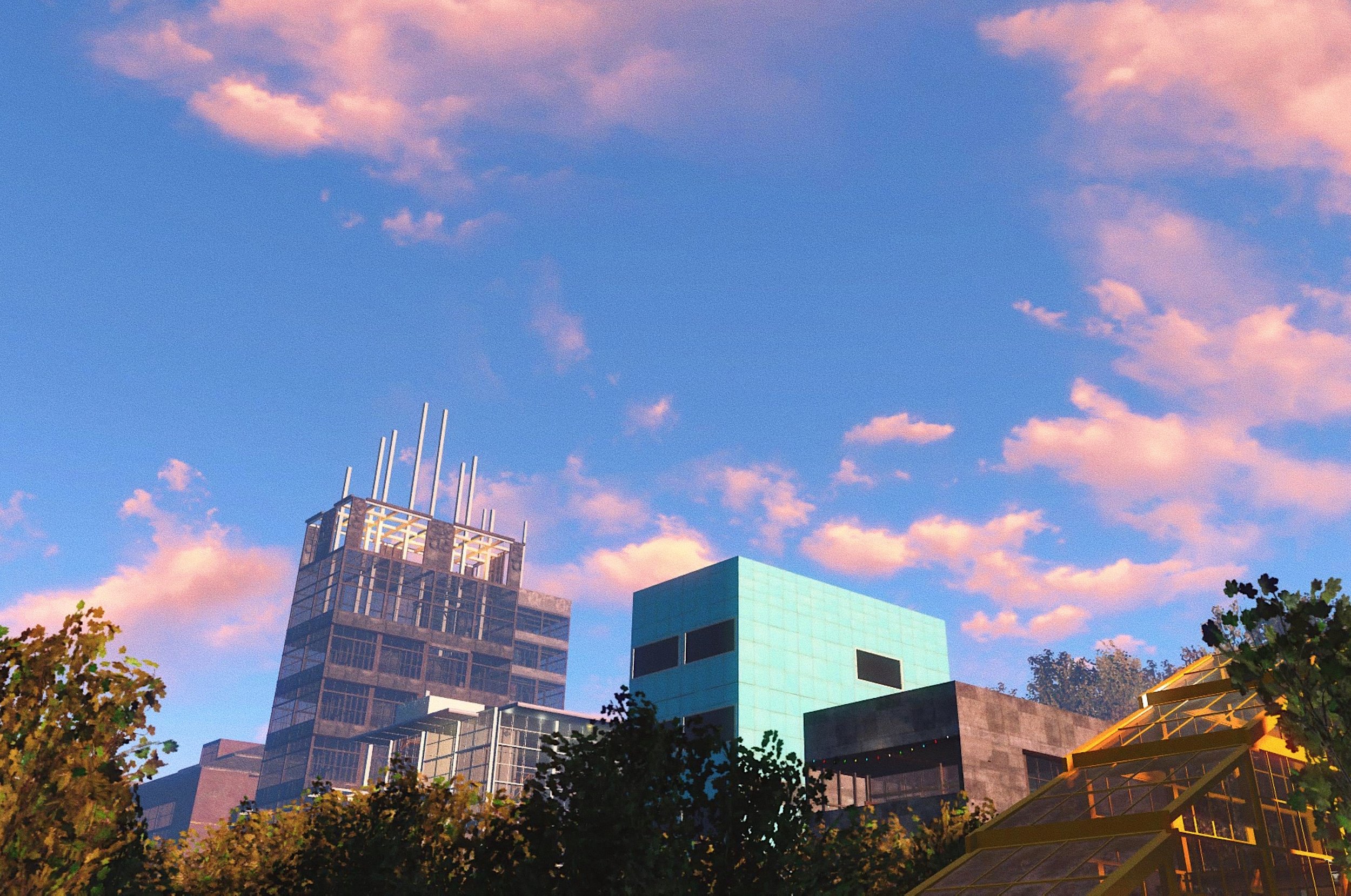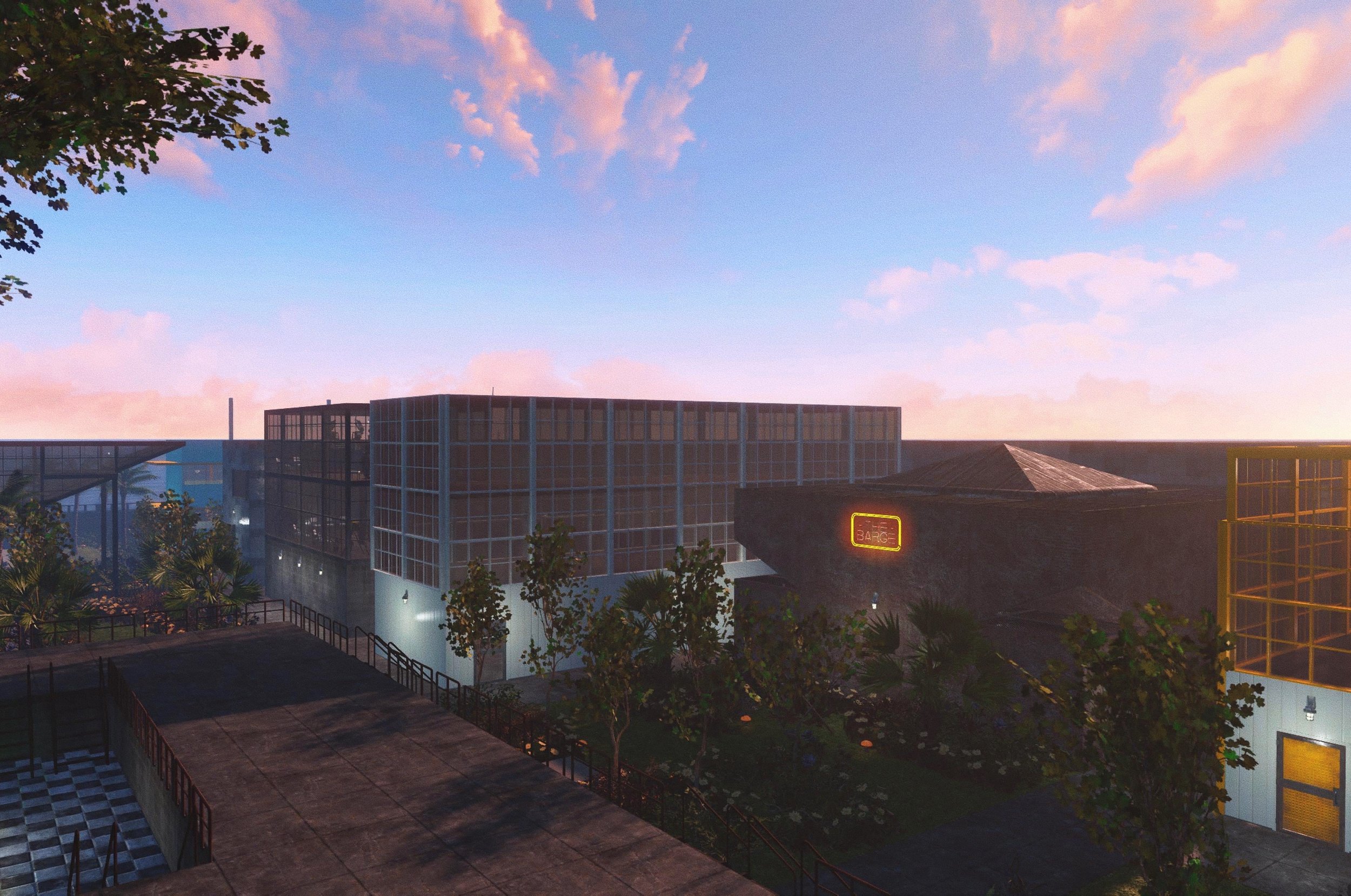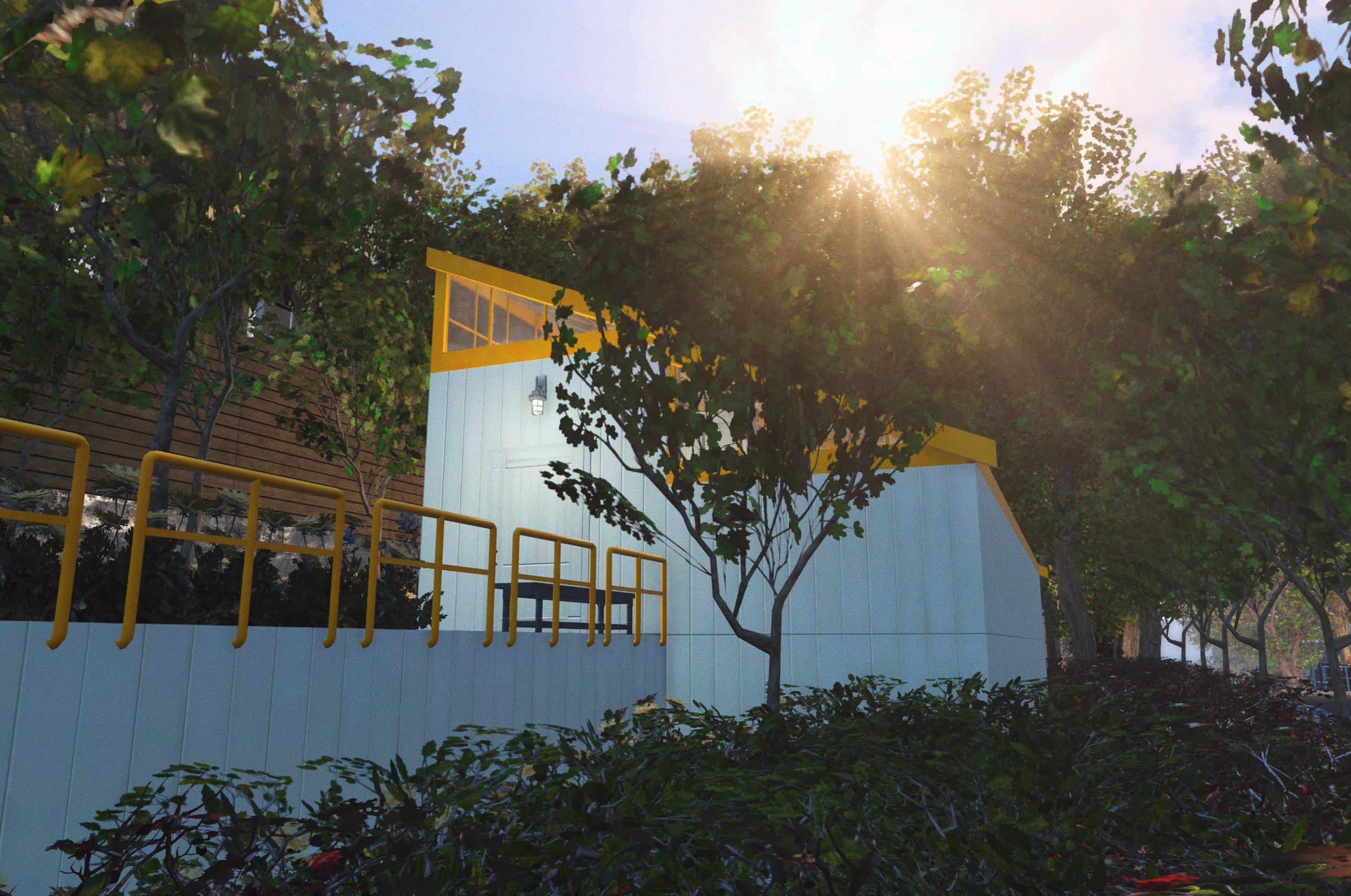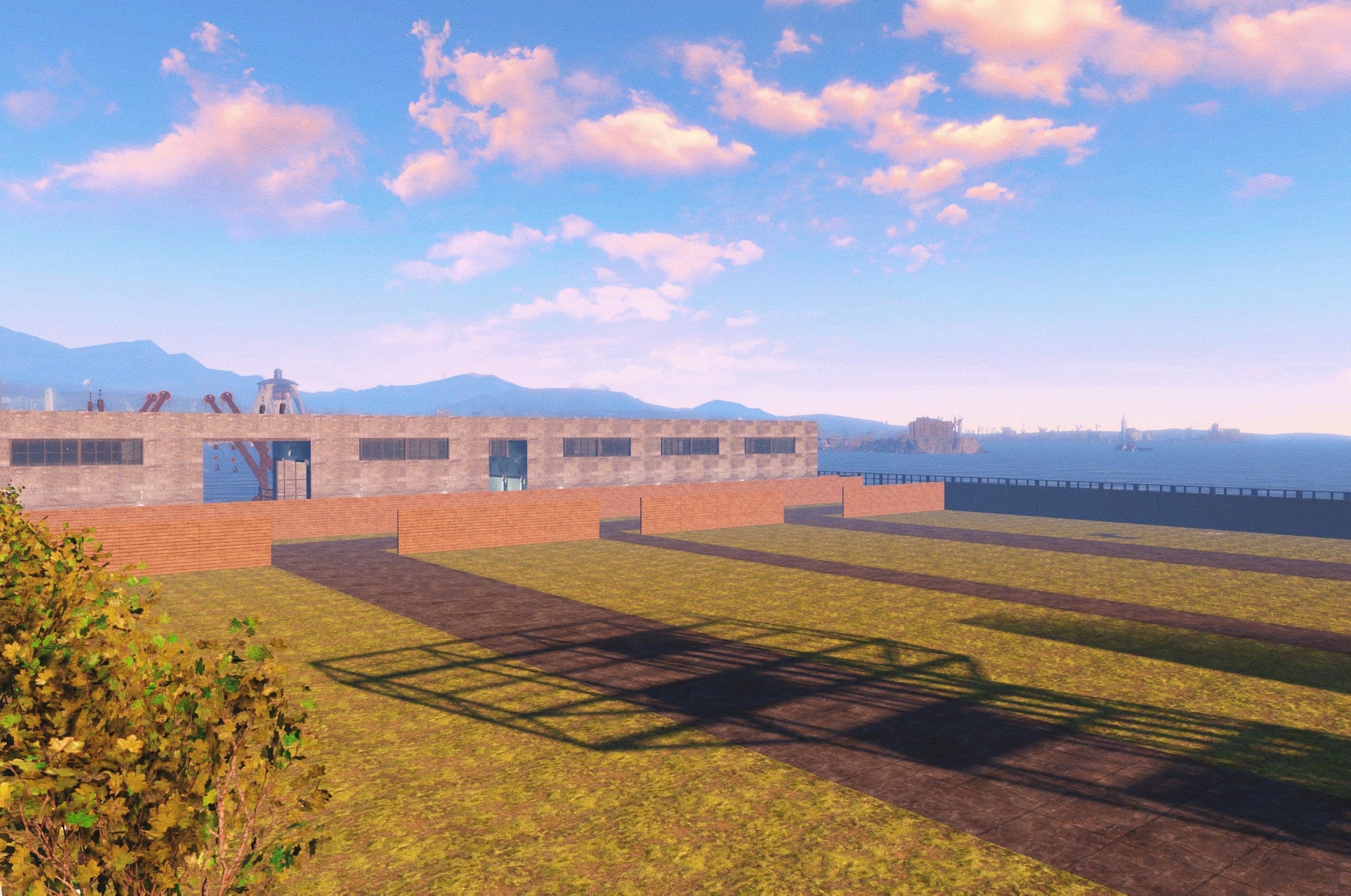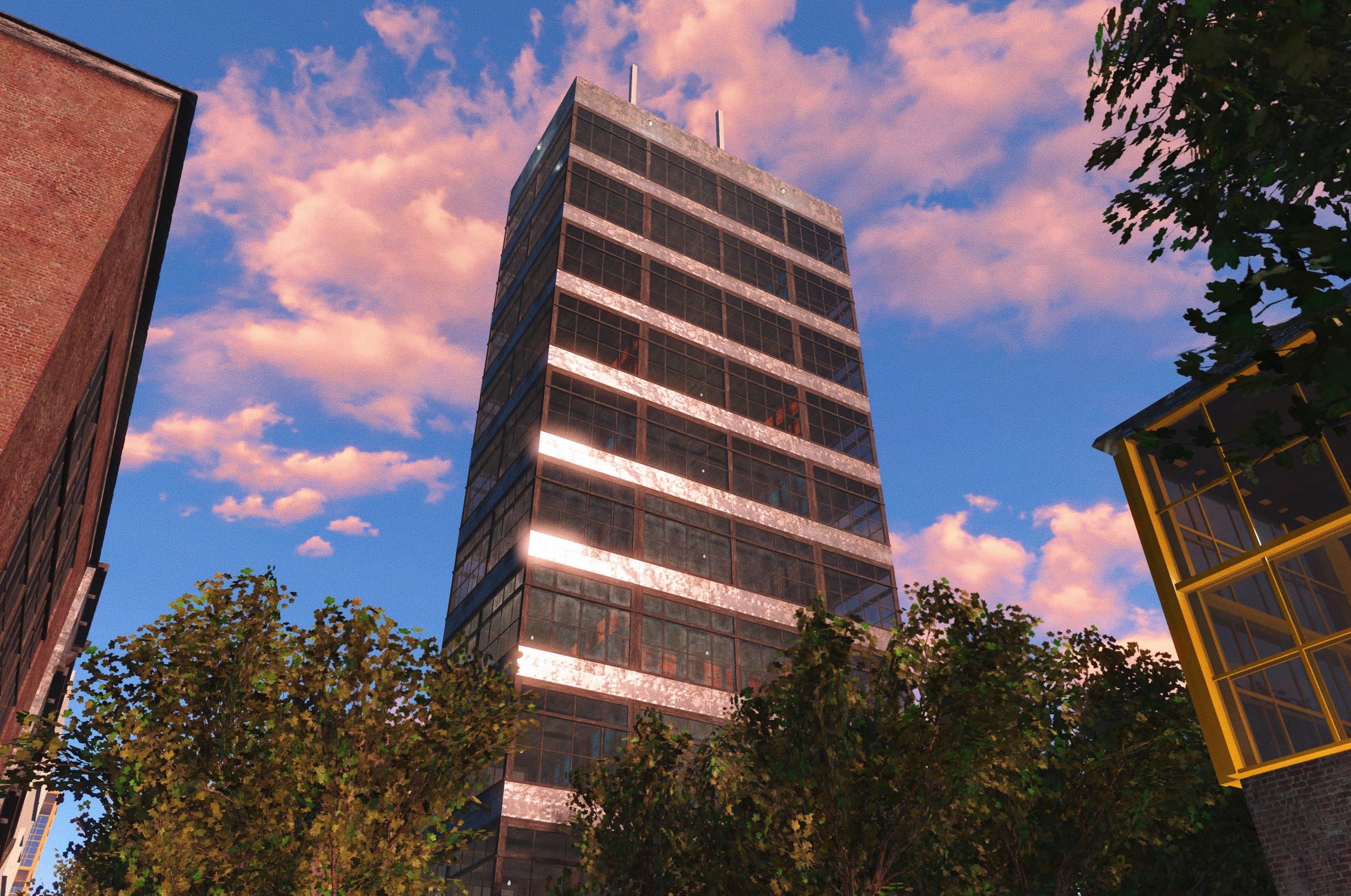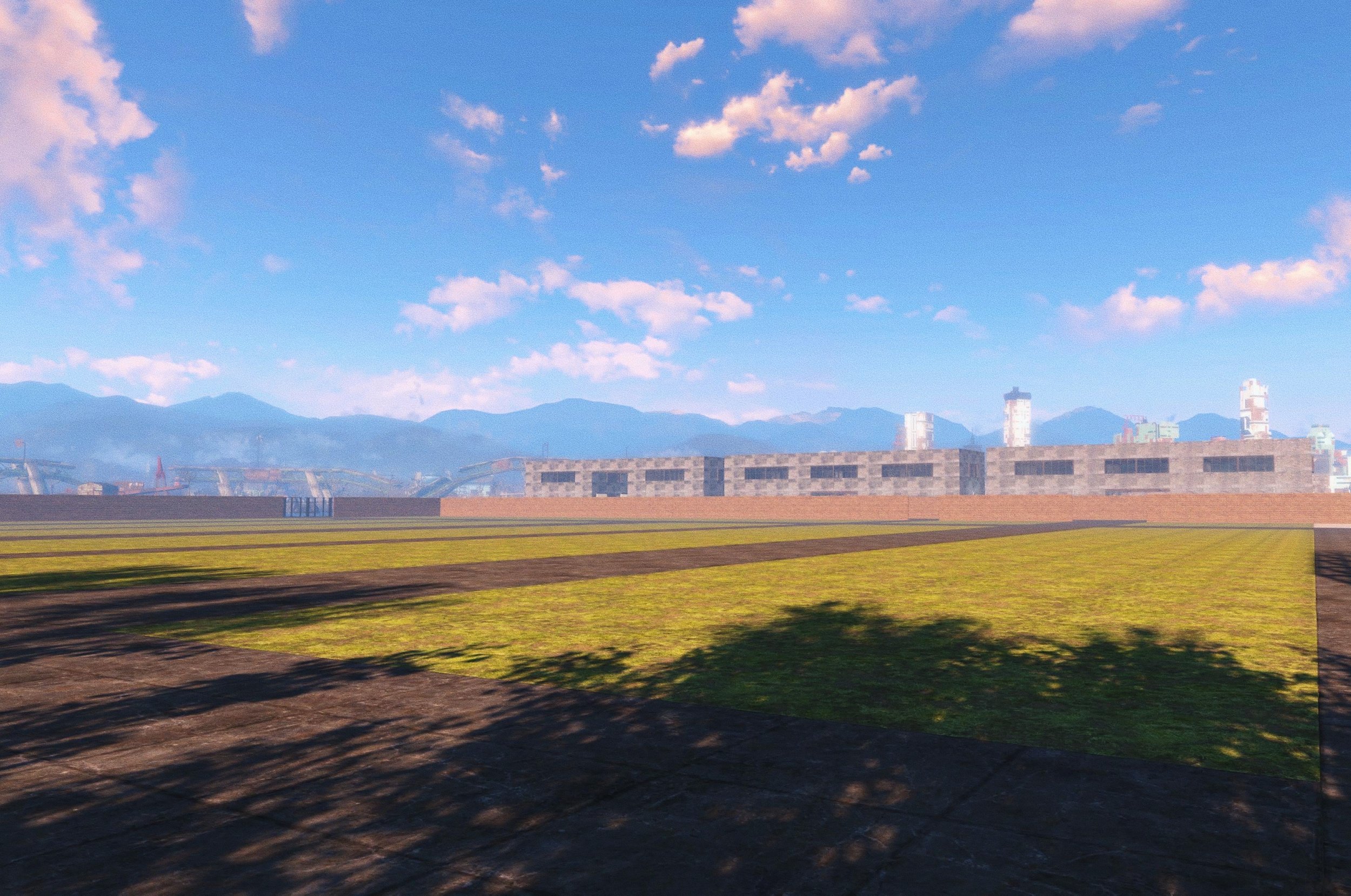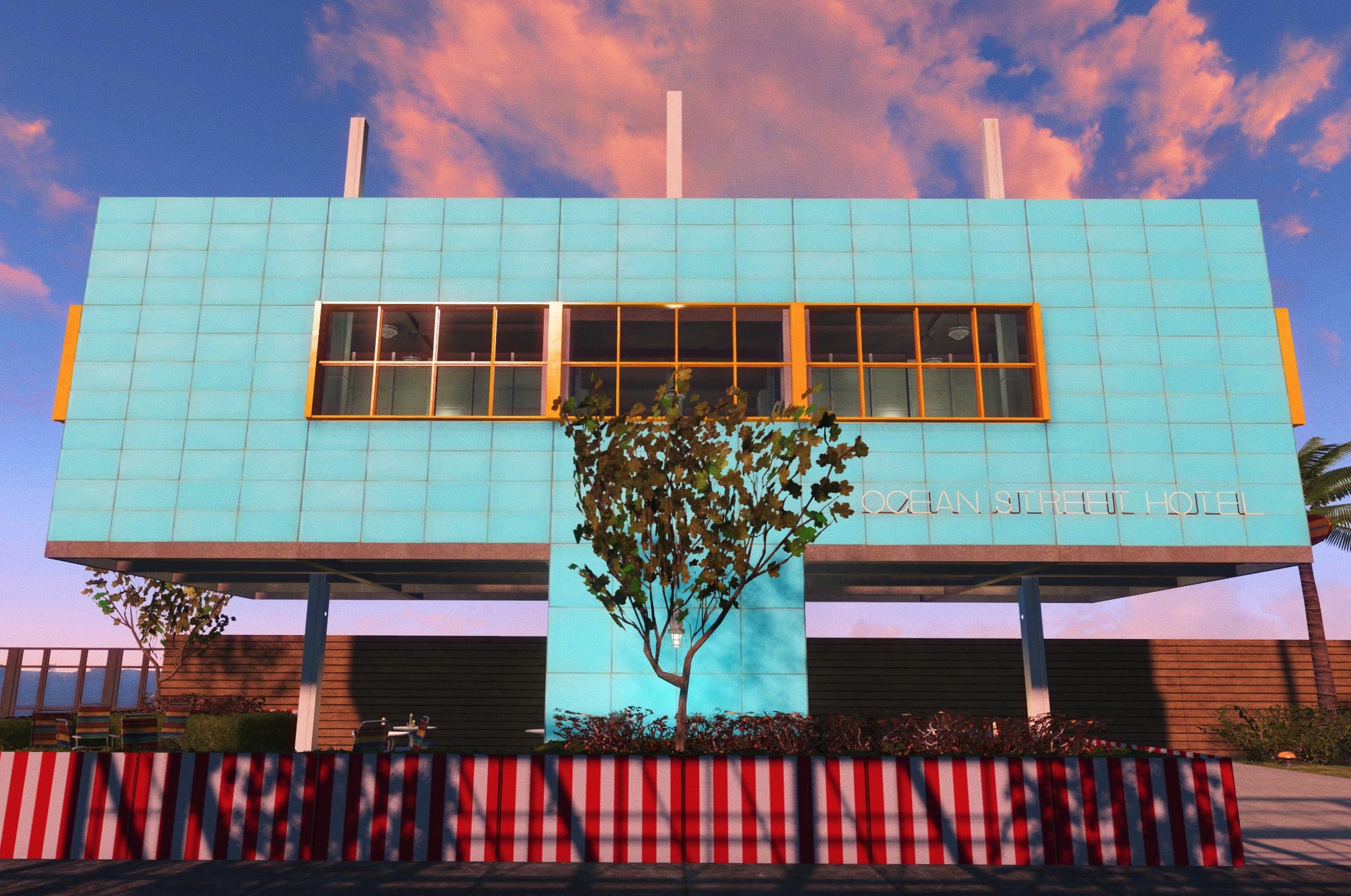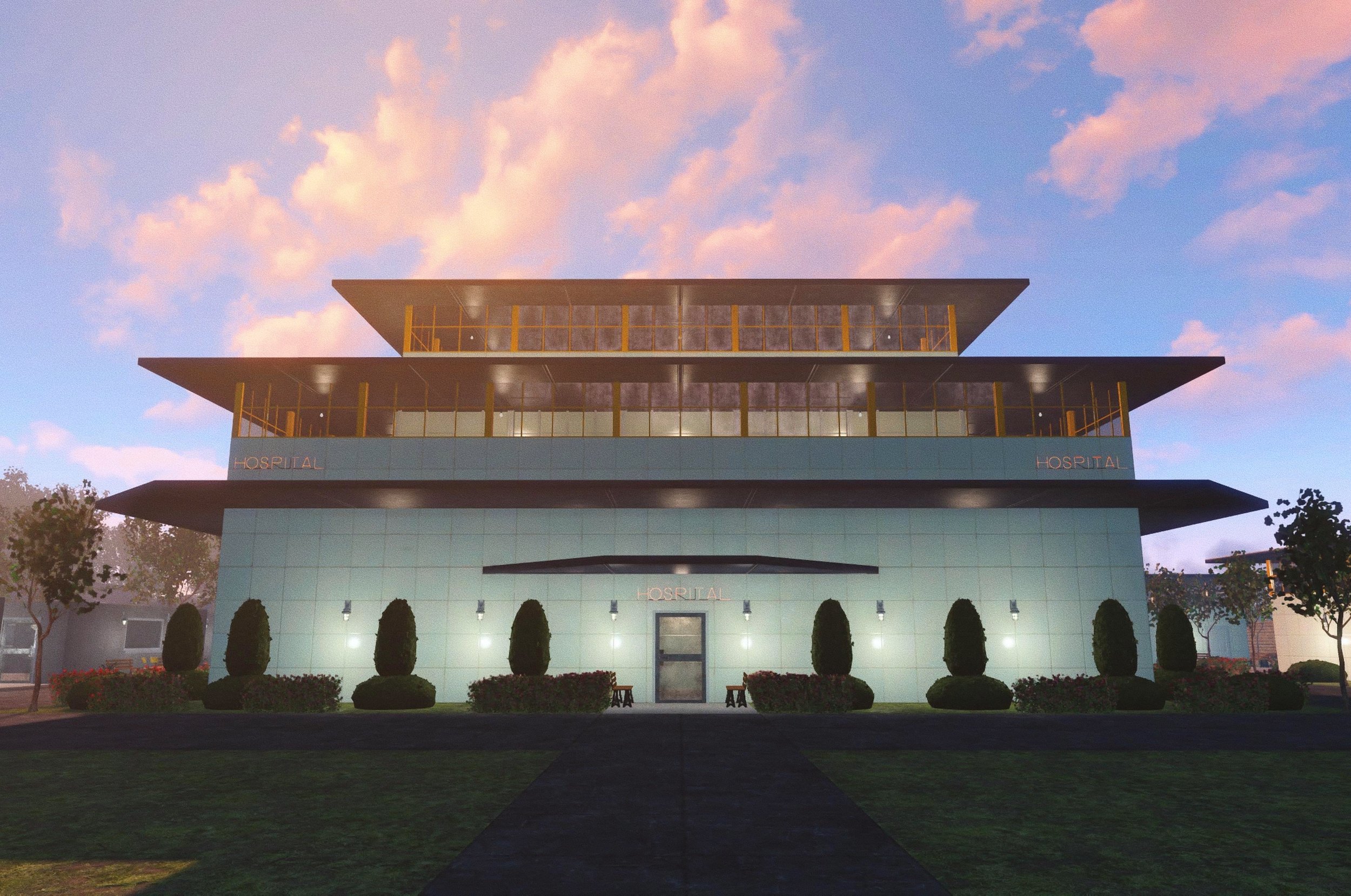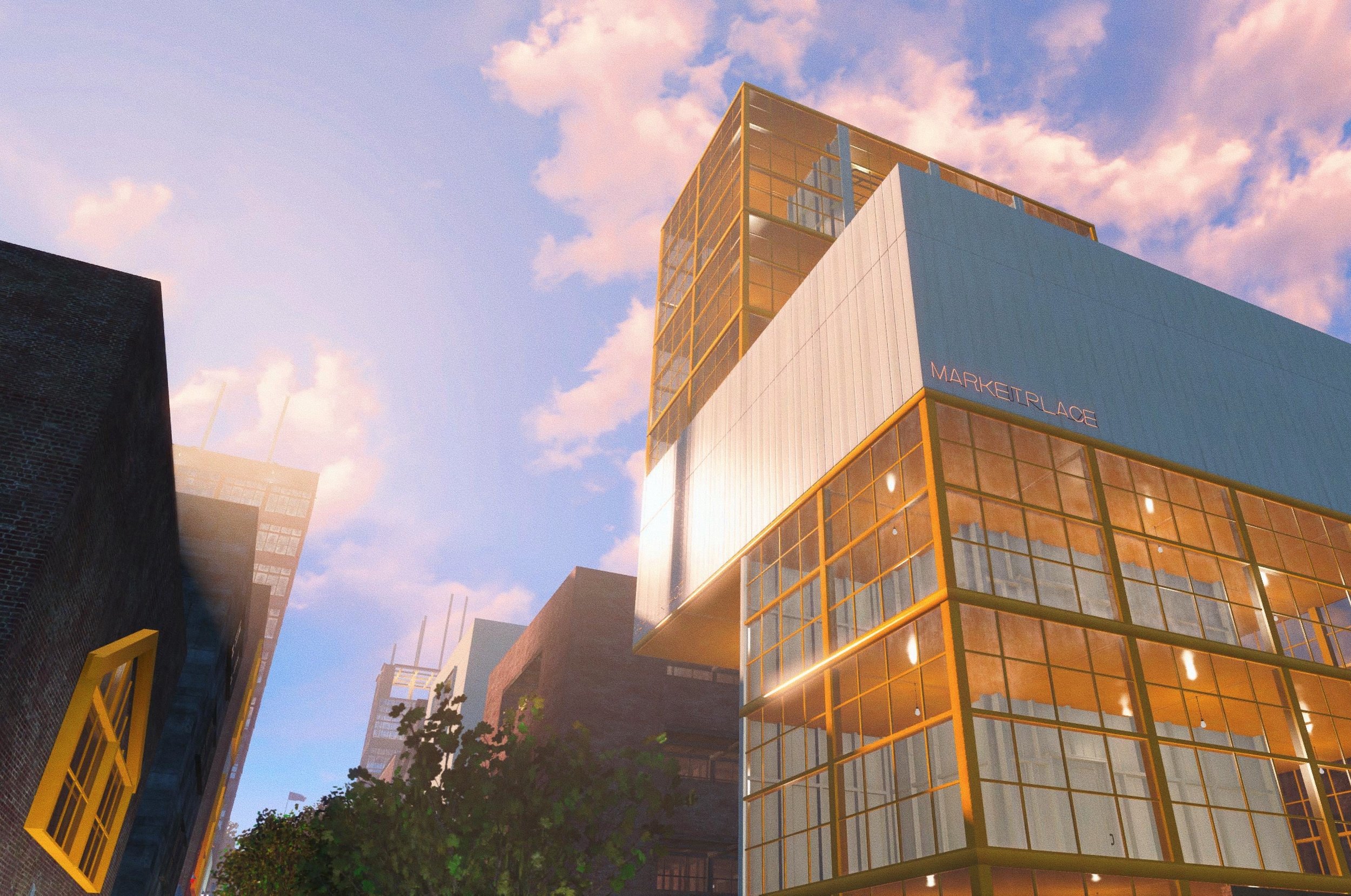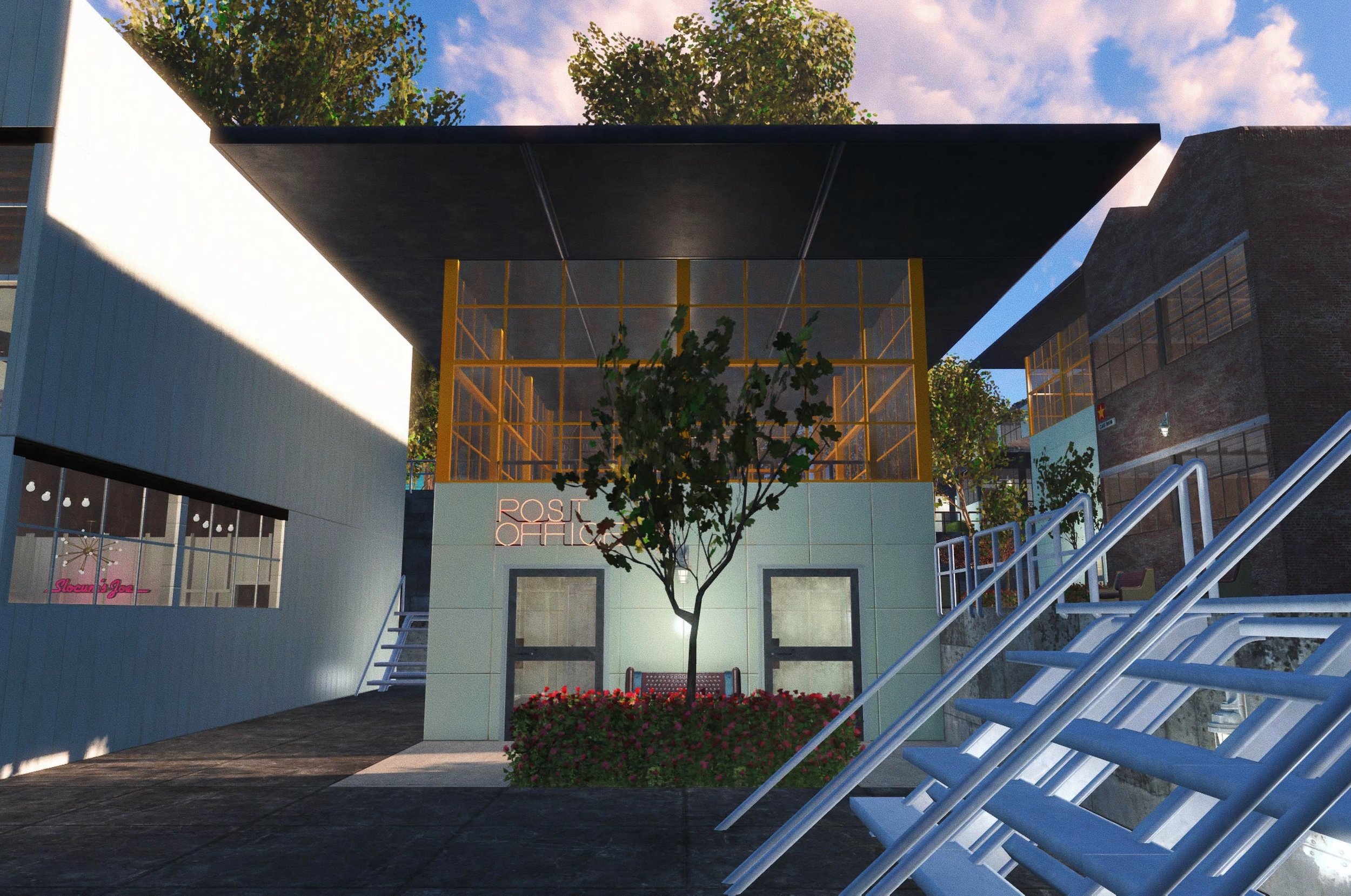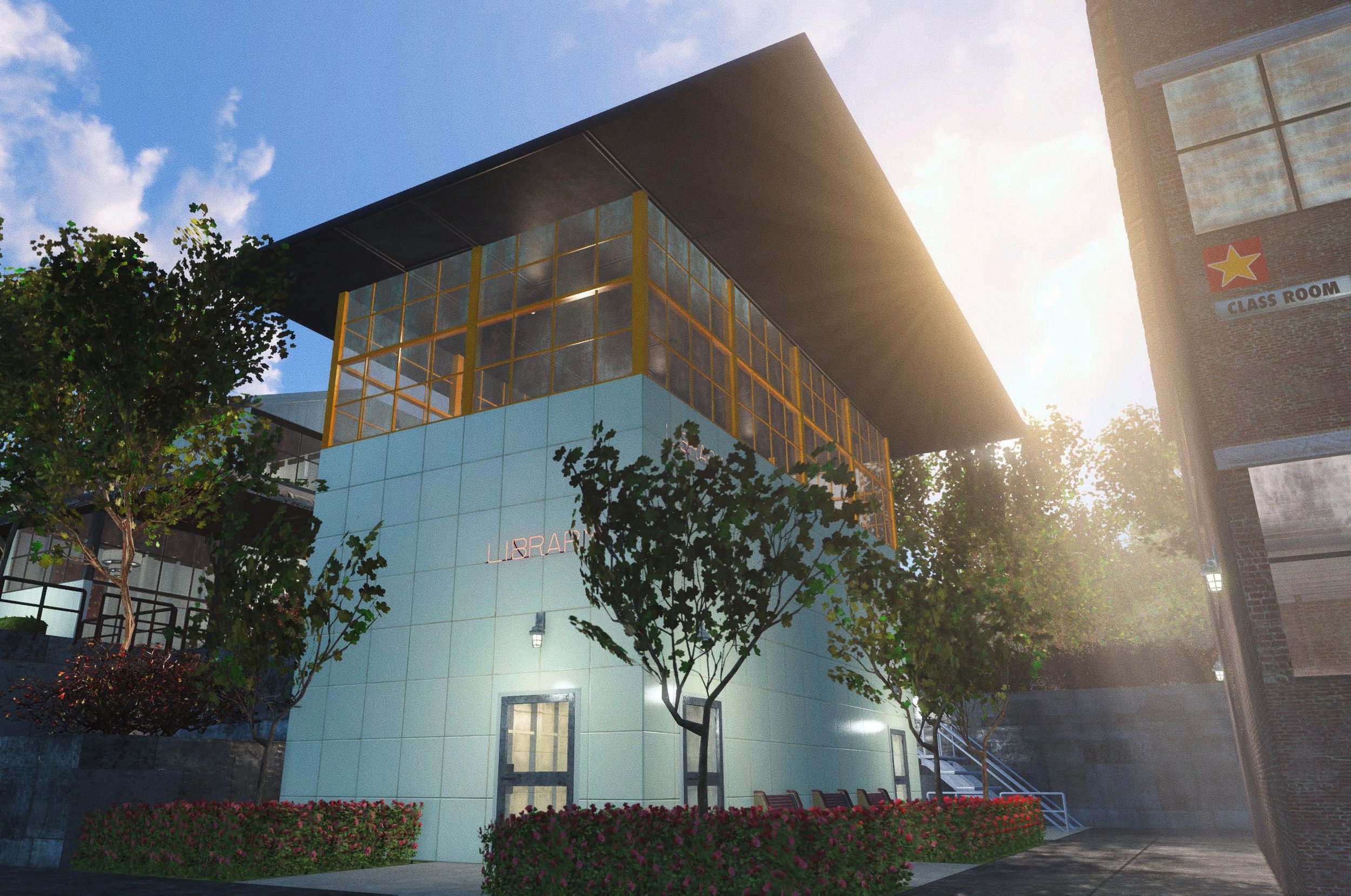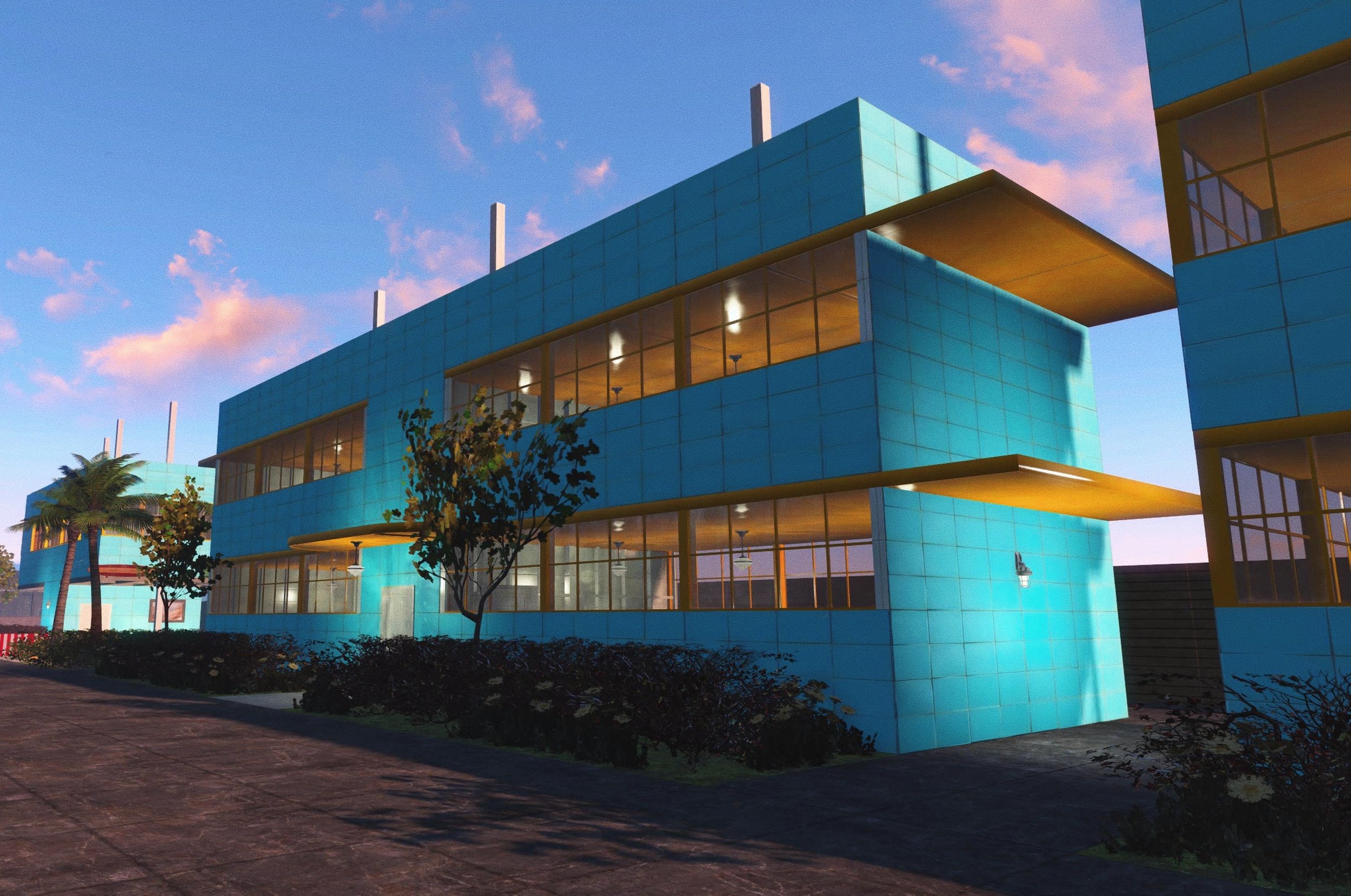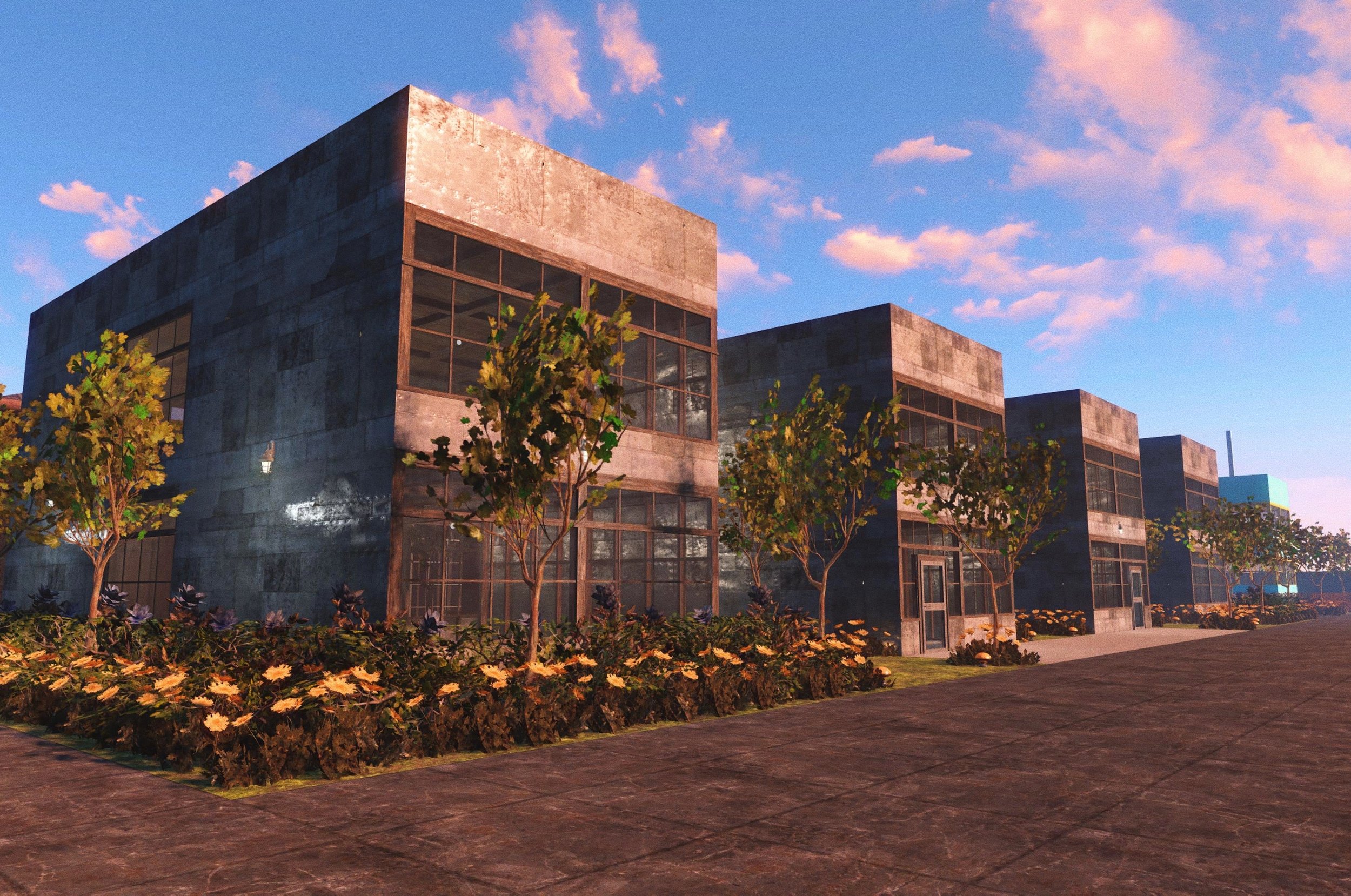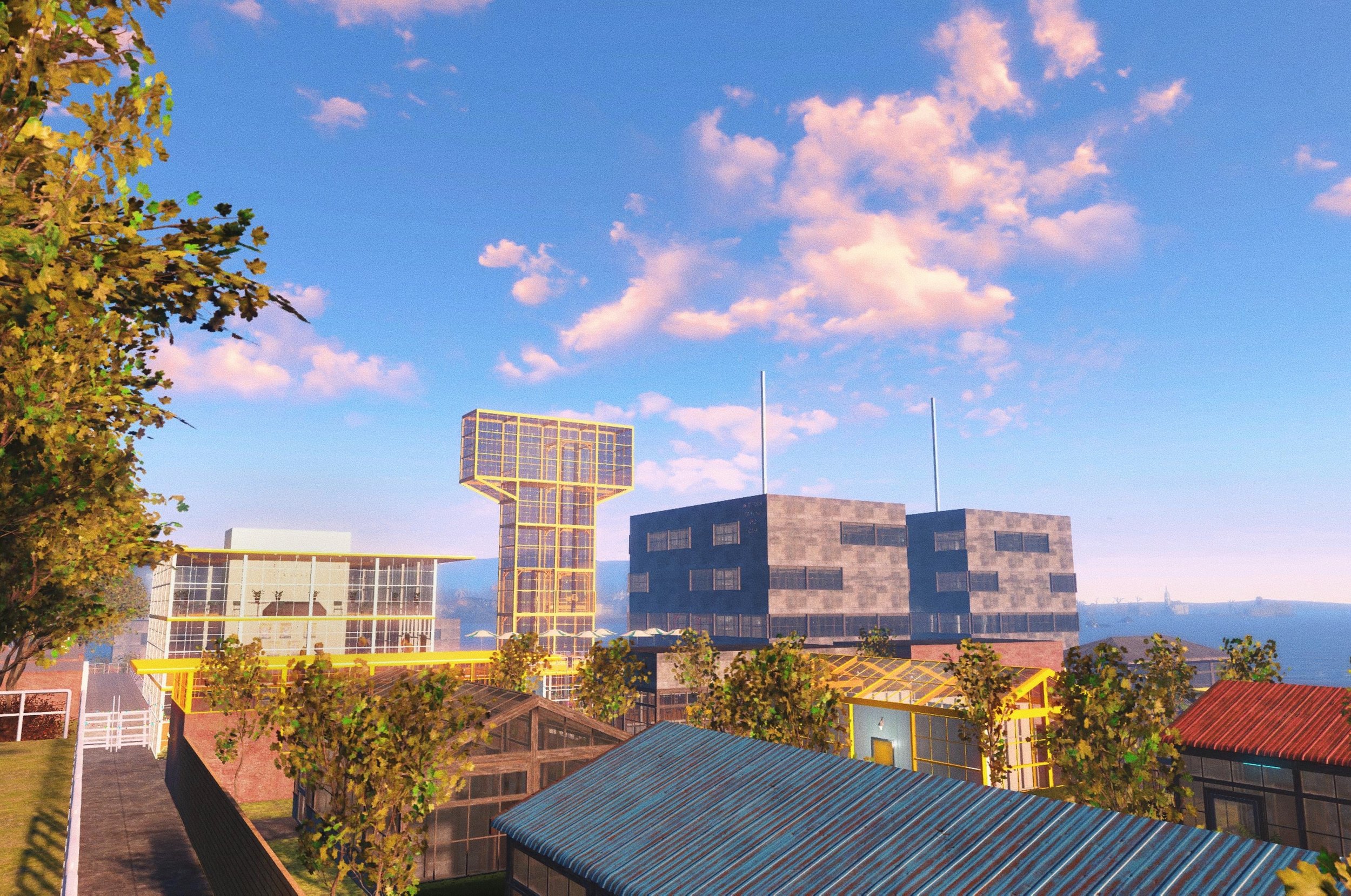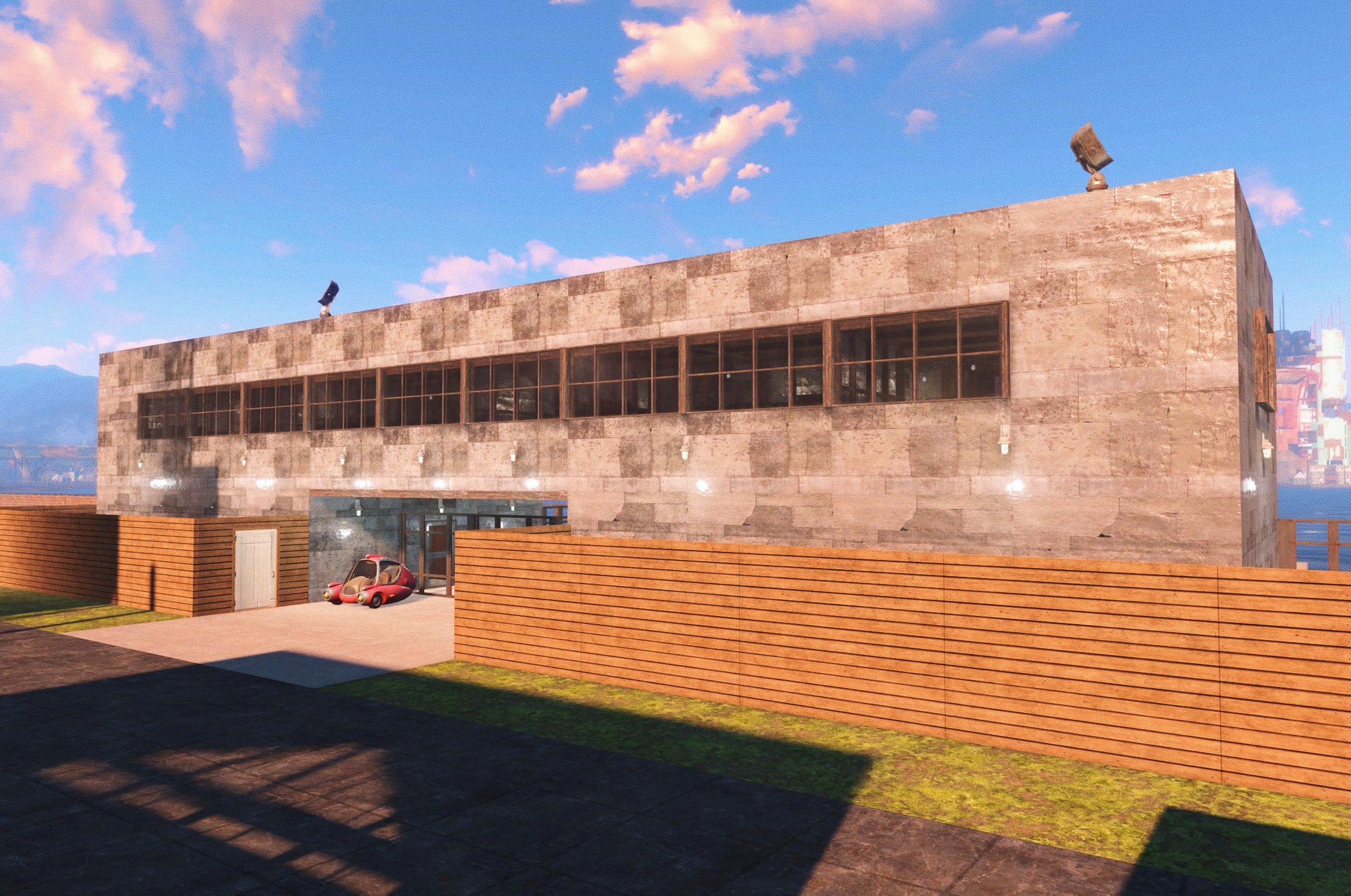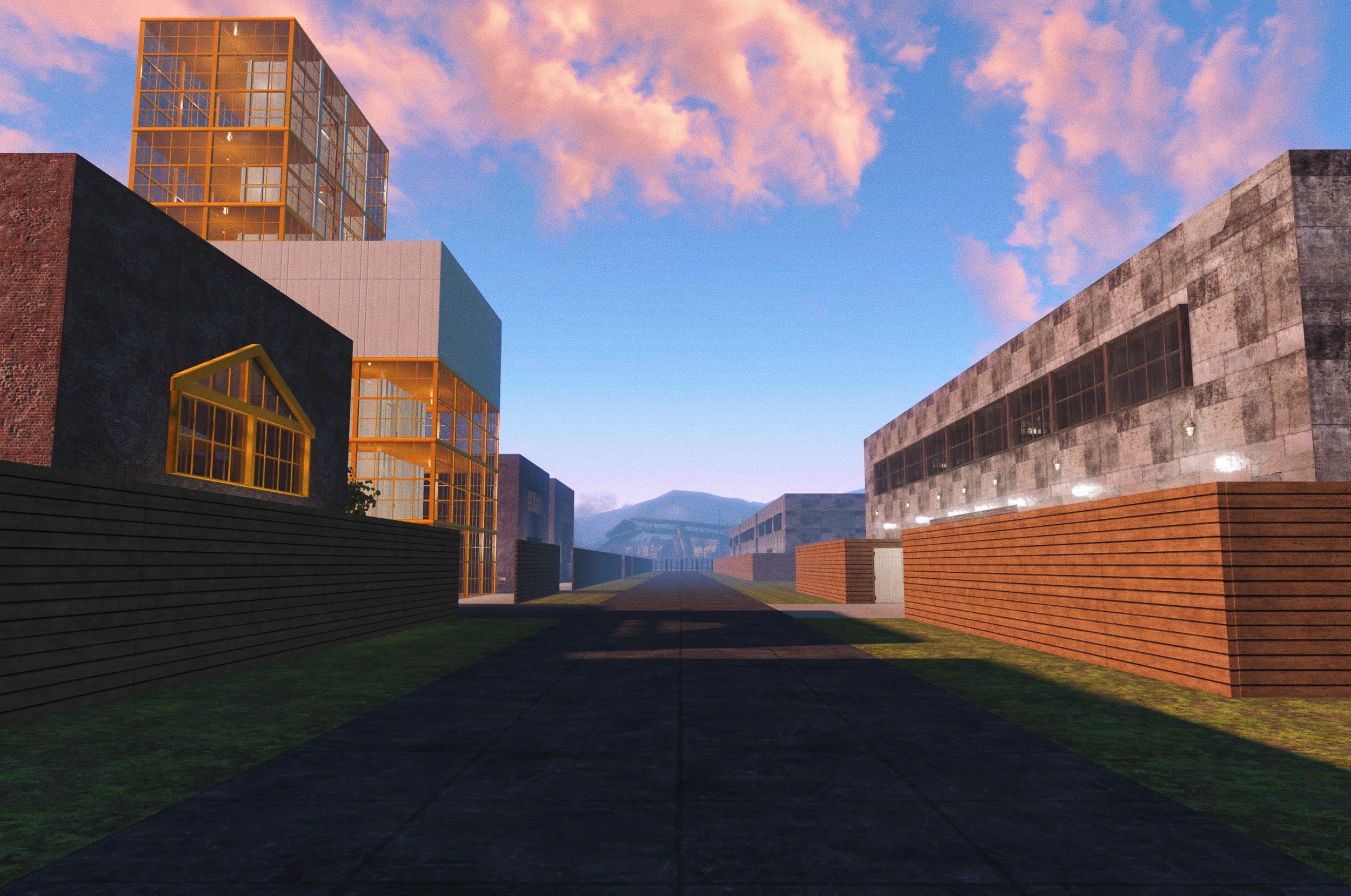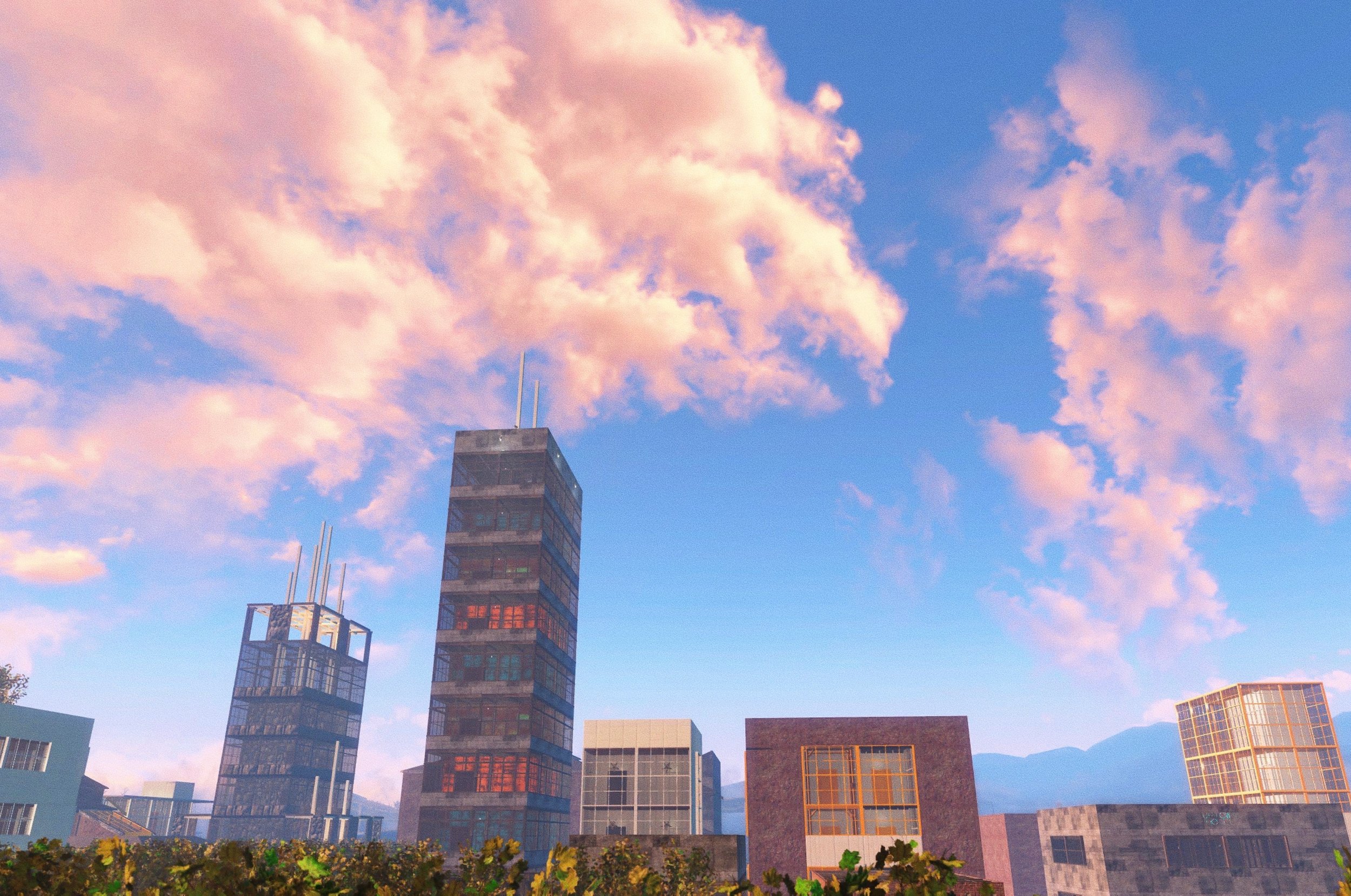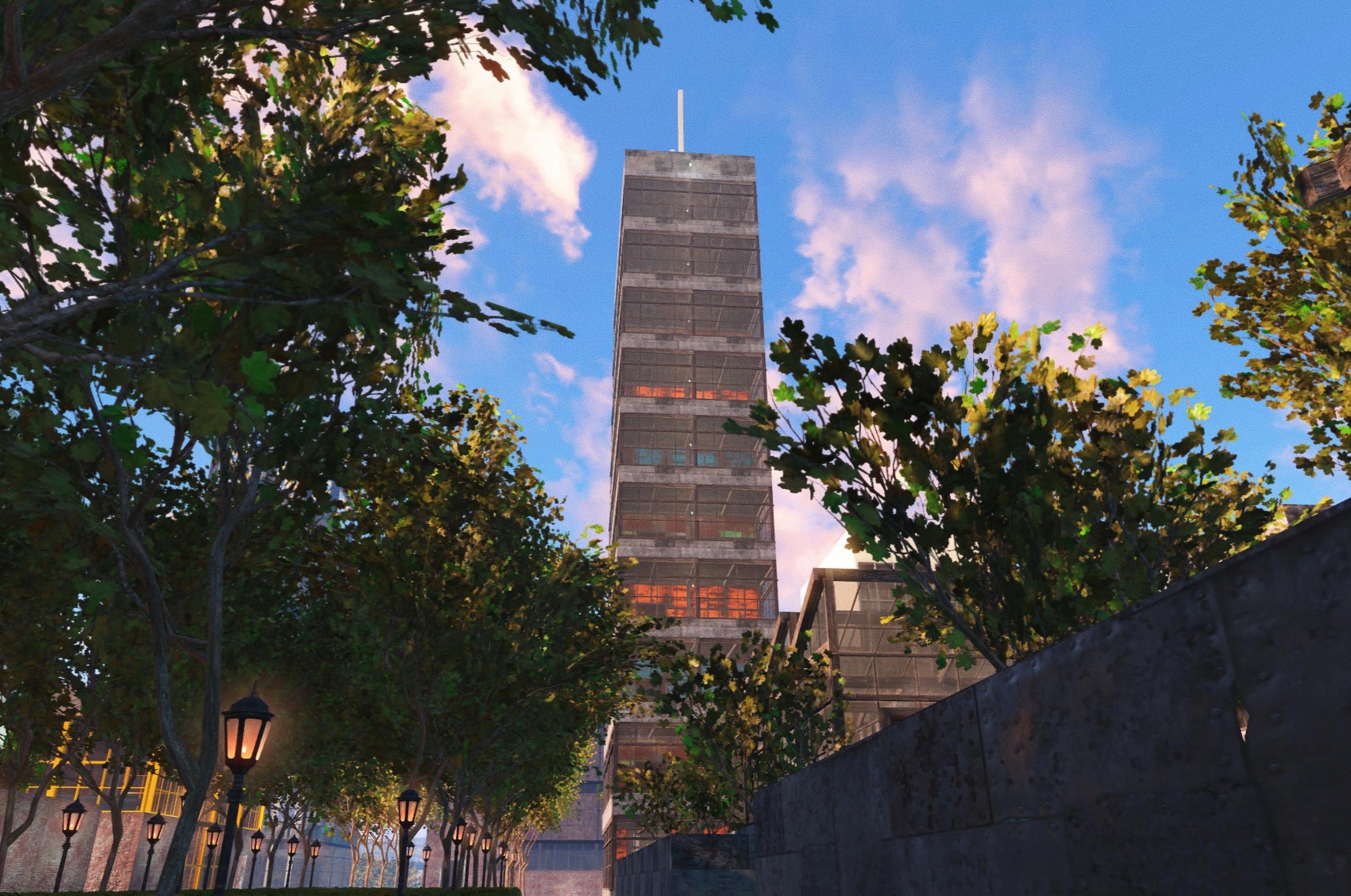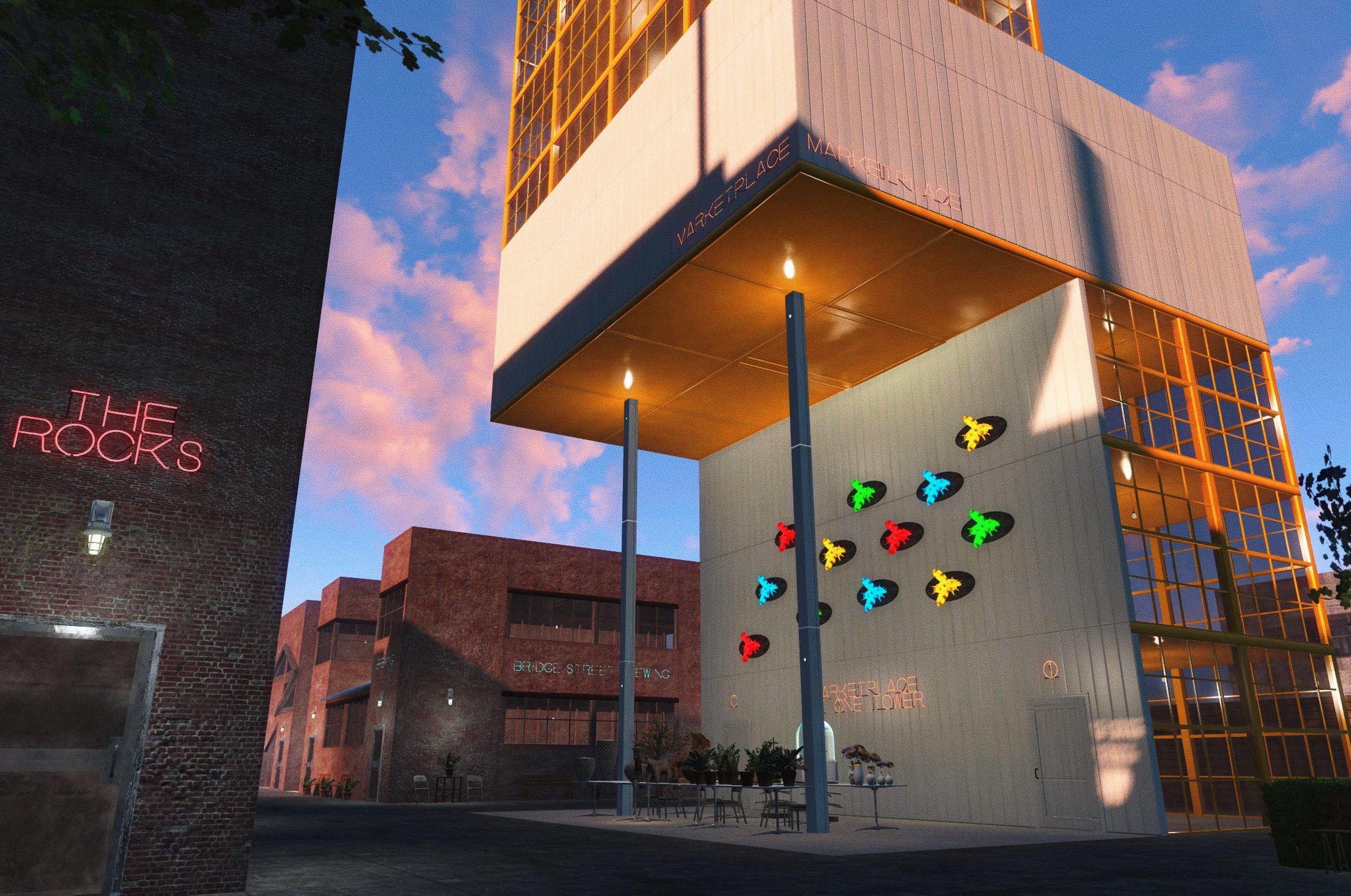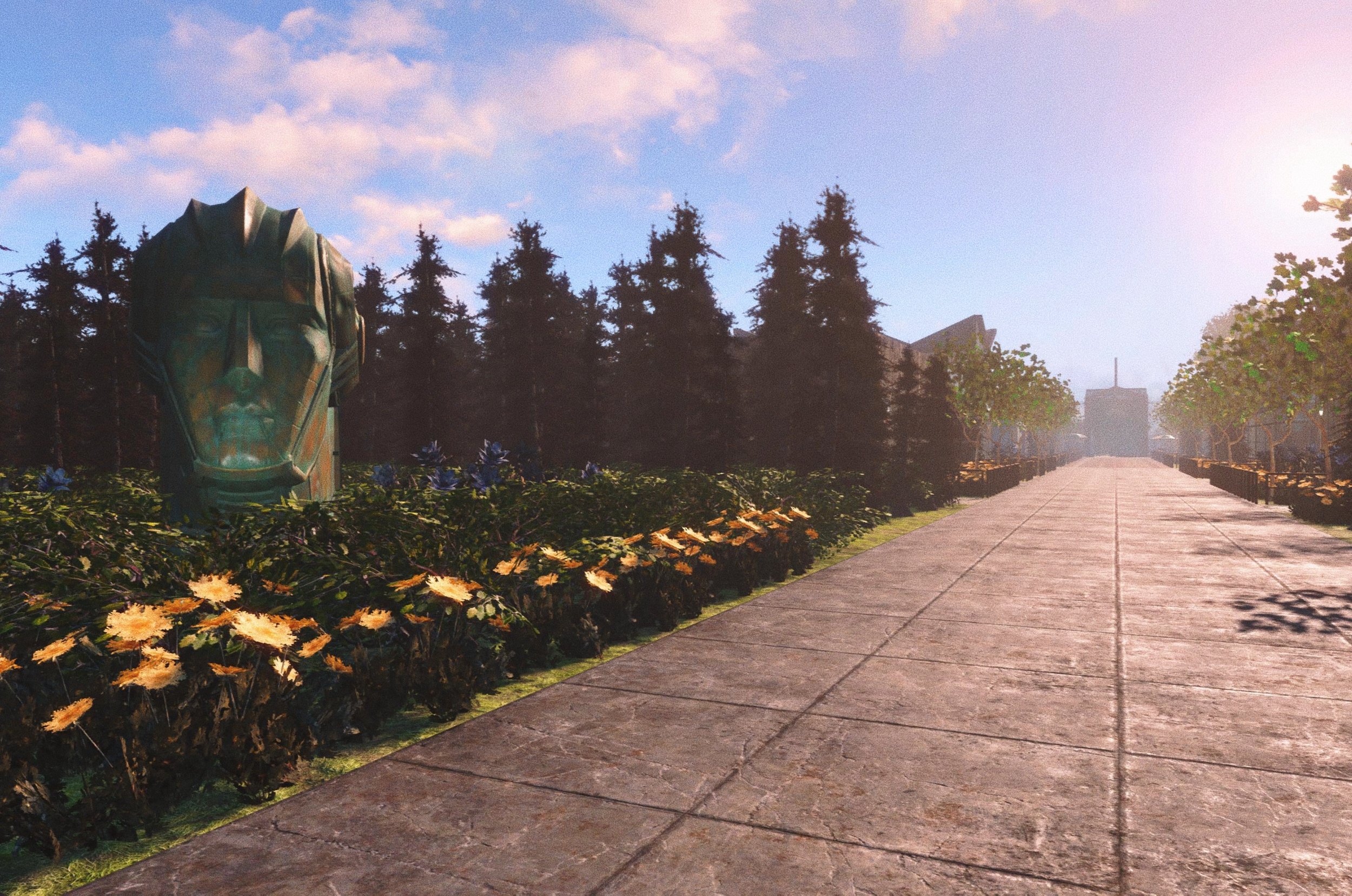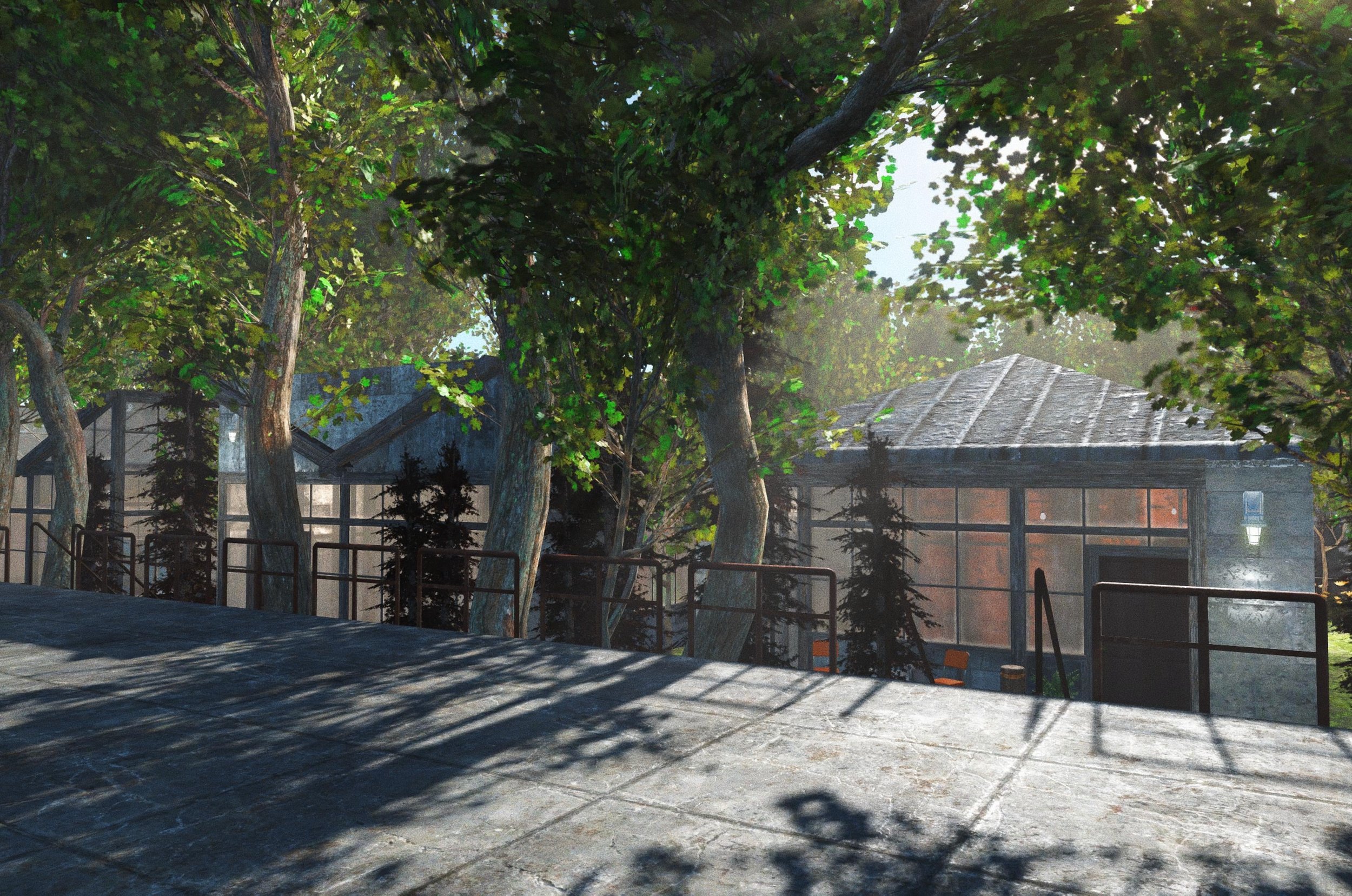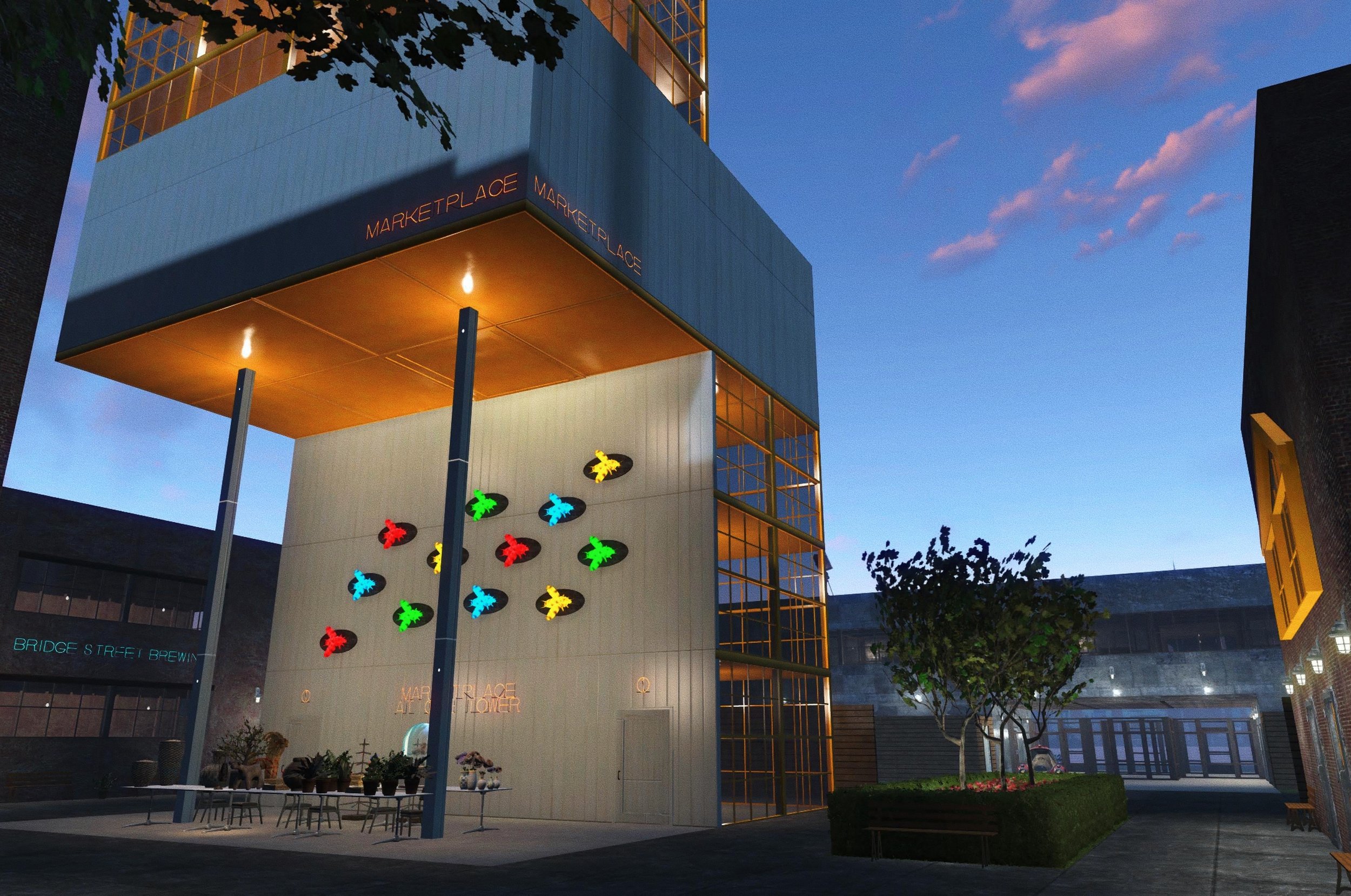Looking north on Ocean Street toward the Midtown skyline.
Spectacle ISLAND: NO LIMITS
Part 5 of the Spectacle Island series. Includes excerpts from past articles by the Spectacle Islander.
LAST — Spectacle Island: united
Spectacle Island is a large, populated city in the Commonwealth located on an island of the same name. The city, which recently transitioned into a unified governing body, has continued to undergo increasingly rapid growth unprecedented in the post-war world, reaching new heights and lengths. In the midst of this growth, city leaders have overhauled their administrative processes and systems, as well as the political boundaries of the island, in order to help mitigate the complications of growth. The island, now divided by six districts–The Barge, Downtown, Lowland, Midtown, Randy, and Uptown–is further divided into neighborhoods and character areas. The new system aims to encourage unique character between the districts through public participation and direct representation in government processes.
A BRIEF HISTORY
New Horizons
A settlement on an island has several benefits in a post-apocalyptic world filled with threats around every corner. This was the understanding behind the original settlers of what is now, less than fifteen years later, a booming, modern city. Those same benefits have not changed–the waters surrounding the city provide natural security from the wasteland–but new problems have surfaced over time. This is not a unique problem for cities. Throughout history, cities all over the world have faced both customary and distinctive problems that have been overcome through both customary and distinctive solutions. However, no city–at least that we know of–has risen from the rubble of a world utterly destroyed by nuclear annihilation. Yet Spectacle Island, more than two hundred years after the bombs fell, has emerged as, perhaps, the first world-class society in this new world. This puts the city in both an exciting and terrifying position at the forefront of the future of civilization. City leaders do not take this position lightly, investing heavily in both short-range and long-range strategies for construction, economics, environmental stewardship, human development, medicine, technology, and more.
Speaking of construction, the city has continued to expand far beyond the original boundaries of the island at an increasingly accelerated rate. Specifically, city leaders championed the Spectacle Island Beltline project, the largest infrastructure project in the city’s history. The Beltline created a road that completely surrounds the city. Within the road, the island was filled-in through land reclamation methods, more than doubling the land area of the city. This land largely remains undeveloped, but the city has plans to create up to six new neighborhoods over time. The project was established as the Spectacle Island Beltline Special Purpose District, a series of municipal buildings and properties along the Beltline including a new border facility, farm, port, and warehouse, among others. This latter portion of the project, dubbed “Project Landfall,” was the solution to a decade-long problem facing the city: a need for industrial facilities with inappropriate or insufficient space for them. Several ideas had been proposed throughout the years–the most recent being Randy hosting these facilities to help reboot its economy–though none ever came to fruition. The city, still eyeing future expansions of its limits, required each building north of the Beltline to include arches on the ground floor where aligned with streets capable of continuous mobility.
New Heights
While the city has expanded its boundaries horizontally, it has also done so vertically through amendments to its development codes. Previously, buildings in the urban center and beyond were only allowed to reach four and a half stories in height. The only buildings on the island that exceed this height are the Capital Building, for which this code was centered around, and the Center of Business and Finance, the latter of which snagged an extra half story through a loophole. The rewrite allows buildings in the city center to reach heights of ten and a half stories for occupied floors not including spires. This launched a mini-boom of high-rises in the Downtown, Midtown, and Uptown neighborhoods, with five new buildings exceeding the previous four-and-a-half story height limit, including: the Island Tower in Uptown at thirteen stories; Main Street Tower in Downtown at eleven and a half stories; Midtown Casino and Hotel at nine and a half stories; Midtown Convention Center and Observation Tower in Midtown at seven and a half stories; and One Tower in Uptown at seven and a half stories.
Back on the ground, dozens of other new buildings and parks have been constructed in existing neighborhoods across the island, notably: the Center of Health and Medicine, a new medical complex featuring a clinic, hospital, laboratory, mortuary, and pharmacy; the expansion of Barge College to include studies in agricultural technology, artificial intelligence, information systems, nuclear technology, and robotics; the transformation of Capital Square in Downtown with a new park, library, and post office, as well as the adjacent Beacon Heights neighborhood which welcomes four new houses; and the spillover of the Hull in Uptown–which welcomes three new museums–into Front Street, a new character area featuring an art gallery, boutique, brewery, and cafe.
WHAT’S NEW
The Barge
Population: 277
Neighborhoods: Barge College, Barge Street, Ocean Street
Character areas: North Barge Street, North Ocean Street, South Barge Street, South Ocean Street
Points of interest:
Named for a barge that ran aground on the east shore of the island, the Barge is known for its breathtaking sunrises, organic ranch-style architecture, green spaces with unique vegetation, and research institute, the Barge Institute of Technology. Before the neighborhood was constructed, the barge that ran aground hundreds of years prior was taken apart and recycled. Several buildings in the neighborhood were constructed using reclaimed materials. The neighborhood features bountiful green space, including two parks: Palm Park, one of only two places on the island where one can find palm trees (the other is along Ocean Street); and Pine Park, home to one of only two Lars Ronald sculptures made from reclaimed materials (the other is at the Standing Building and can be viewed in the Gravel Garden).
Barge College
Barge Street
Ocean Street
Downtown
Population: 1,023
Neighborhoods: South Main Street, Beacon Heights, Overlook
Character areas: Bridge Street, Capital Square, Center of Health and Medicine, East Beacon Heights, North Avenue, West Beacon Heights
Points of interest:
The cultural and literal capital of the island, Downtown has a bit of everything: art, bars, culture, history, live music, restaurants, and shops, not to mention its largest industries: government and hospitality. In addition to its punch-packing lineup of things to do, visitors and residents are treated to an historic collection of post-war architecture and landscaped parks. South Main Street, the first planned and second built street on the island, is today the central business district and is functioning just as intended. Bars and restaurants, hotels, offices, residential apartments, and stores, among others, pack the floors of beloved buildings that tower over the street. Bridge Street, formerly Alley Street, hosts the largest collection of breweries on the island. Capital Square, the terminus of Main Street, features the Capital Building. Overlooking Main Street is the city’s first residential district, Overlook, which features eight jewels of residential architecture as well as All Souls Chapel and the Mayor’s Mansion. Beacon Heights, a tree-covered community comprising the aptly named Beacon Heights Avenue, is home to several residential jewels, such as the beloved Horn House, as well as Beacon Heights Park including the Beacon, a historic radio tower structure constructed by Randy, an original settler.
South Main Street
Overlook
Beacon Heights
Lowland
Population: 256
Neighborhoods: Lowland Village, Lowland College
Character areas: Lady of the Bay, Lowland Avenue
Points of interest:
Many know and love Lowland for its artisanship, environmentally-friendly architecture, progressivism, and scenic bayside views. Lesser known is its history driven by grassroots activism. In the early stages of the construction of the city, some residents became concerned about the impact the relentless development of the island was having on the environment and its population. This fueled a fight for secession from the city to form a new self-governing settlement to be called Lowland in reference to its low elevation on the island. After a long period of back-and-forth, the settlement was adopted as the city’s first special district and granted certain self-governing powers. The district’s founding serves as a testament to its character and culture. Today, the district features two neighborhoods: Lowland Village, featuring the commercial and residential areas, and Lowland College, a private research institute that has a little for everyone—the architect, the artist, businessman, doctor, lawyer, nurse, politician, scientist, and teacher, among others—nestled on a scenic hillside with spectacular views of the bay and city.
Lowland Village
Lowland College
Midtown
Population: 338
Neighborhoods: East North Avenue, East Avenue
Character areas: North East Avenue, The Vault
Points of interest:
Between Downtown and Uptown to the east lies Midtown. Largely touted as an entertainment destination, the district features the island’s first casino, observation tower, and virtual reality lounge. Due to the political restructuring of the island, district leaders are able to attract certain businesses previously prohibited under the previous government. The district plans to construct a new neighborhood, Vault Town, to allow establishments with uses such as drug use, erotic dancing, and gambling, among others, including virtual reality pods that allow users to experience an array of digital fantasies including sex, time travel, and violence. The district is largely built along two major corridors, East Avenue and North Avenue, which connect Downtown and Uptown to the east side of the city. East Avenue is a charming neighborhood filled with renowned residential architecture and some of the best sunrise views in the Commonwealth. North Avenue Park, a fairy tale-like green space with canopy trees lit by lanterns, is a setting unlike any other on the island. At the terminus of East North Avenue lies a commercial pocket with hotels, bars, a casino, restaurants, shopping, and the Vault-Tec Museum, the latter of which features an entrance to the Vault, a below-ground shopping center with access to Uptown.
East North Avenue
East Avenue
Randy
Population: 328
Neighborhoods: Old Town, Bend, Coastal Forest, West Avenue
Character areas: East Coastal Forest, Sunrise, Warehouse District, West Coastal Forest
Points of interest:
Randy, formerly its own self-governing settlement, still stands on its own as a political district in terms of architecture, entertainment, historic preservation, and nature. Randy features the largest land area of any district, hosting four neighborhoods: Old Town, Bend, Coastal Forest, and West Avenue. Despite its large size, the district is the second lowest in population. This did not happen by accident. While the complicated history of the district had some impact on today’s population, the low numbers are largely a result of urban planning strategies focused on community-centered goals, including land conservation and community resiliency. Four parks sit on each side of the district, with beautifully landscaped yards and streetscaping in between. Thousands of flowers, plants, and trees were planted during the revitalization process just a few years ago. Most of the trees planted were pines, a species not previously found on the island, which has led to a new nickname for the neighborhood from newcomers: “pine town.”
Old Town
Bend
Coastal Forest
West Avenue
Uptown
Population: 849
Neighborhoods: North Main Street, Park Court
Character areas: Front Row, Front Street, the Hull
Points of interest:
Though it partially lies downhill from Downtown, Uptown is the northernmost neighborhood on the island, hence its name. The district is a key business and cultural hub that serves as the gateway to the island. North Main Street is a major commercial and financial hub home to the tallest building on the island, the Island Tower, as well as more tall buildings than any other neighborhood. The Hull hosts four museums: the Children’s Museum, Museum of Art, Museum of History, and Museum of Science; the Theater of Performing Arts; and the Yard, a public green space in the center of the buildings. Park Court is a residential street tucked between the park and skyline with a garden overlooking Front Row, a minor commercial area home to Front Row Office Park, Front Row Green, and an entrance to the Vault, a below-ground shopping center with access to Midtown.
North Main Street
Park Court
Beltline Special Purpose District
The Spectacle Island Beltline Special Purpose District, or the Beltline, is the largest infrastructure project in the history of the city–and likely in the post-war world. A road, well beyond the original city limits, was constructed around the city, completely surrounding it. In all of that space between the original city limits and the new road, the island was filled in through land reclamation methods. This area is fenced along the entire boundary of the city, both internally and externally, providing privacy and safety to the city. Along the road are a series of municipal buildings and properties including a new border facility, farm, port, and warehouse, among others.
A travel guide
Where to…
EAT—Start the day with breakfast and coffee at Main’s Treat in Downtown; for lunch, have a refreshing beverage and sandwich at NoMa Café in Uptown; and for dinner, enjoy an upscale dining experience at Uncommon Brahmin, conveniently located in the ground floor of the Midtown Casino and Hotel.
DRINK—After dinner, have a nightcap at any of the three bars located in the Midtown Casino and Hotel: the Eastern, Glow, and Good Days; have a beer at Bridge Street Brewing in Uptown; try the carrot flower ale from Alley Street Brewing at the Alley in Downtown; or enjoy an elegant cocktail at Breeze in the Barge.
PLAY—Stroll through Capital Park on your way to the Spectacle Island Library in Downtown; check out any of the three new museums at the Hull in Uptown: the Children’s Museum, Museum of Art, and Museum of Science; or immerse yourself in a vast array of experiences in virtual reality at Vault 69 in Midtown. While you’re there, zip to the top of the Midtown Convention Center and Observation Tower for spectacular views of the skyline.
STAY—Stay at the Ocean Street Hotel in the Barge with gorgeous ocean views; the Midtown Casino and Hotel in Midtown, the largest building on the island filled to the brim with things to do, including sleep; the Downtown Hotel in Downtown in the new Main Street Tower; or the new hotel in the basement of the Mayor’s Mansion in Downtown, aptly called the Mayor’s Mansion Hotel and Resort.
NEXT—As large swaths of reclaimed land remain undeveloped across the island, it should not be surprising that city leaders have much more planned for the city. Six new neighborhoods–Camp in the Barge, Low Sun in Randy, Vault Town in Midtown, West Central in Downtown, and Bayfront and West Front in Uptown–are planned, each with a totally different vernacular. Additionally, the newly-formed Island Group aims to improve the city’s, and Commonwealth’s, economy by establishing a network of high-security trade and travel routes and stations, as well as providing services to other settlements throughout the Commonwealth. The group aims to manage and fund interested agencies or parties in order to unify the Commonwealth’s economy and infrastructure, weaving the cultural and physical influence of the city deeper into the wasteland.
